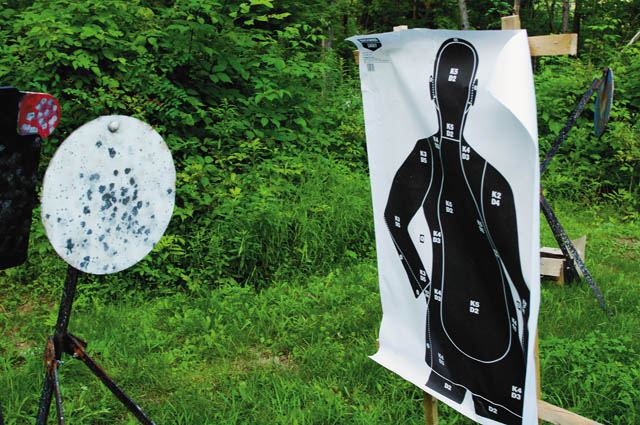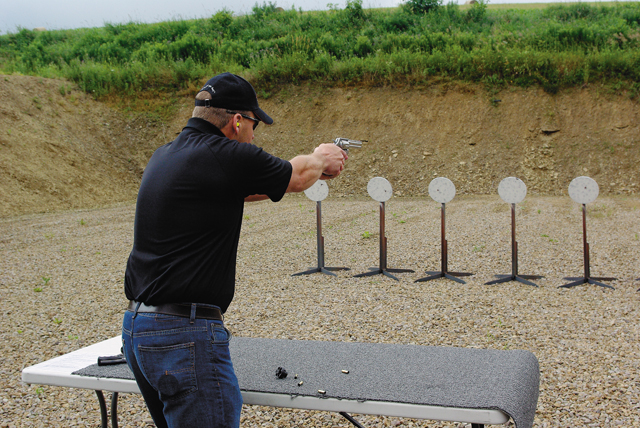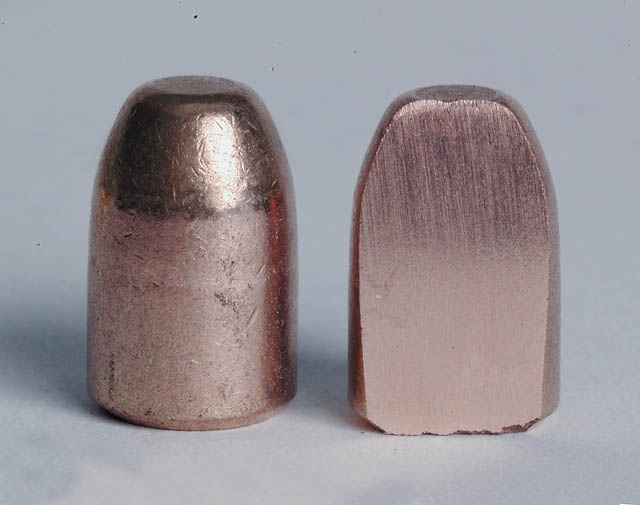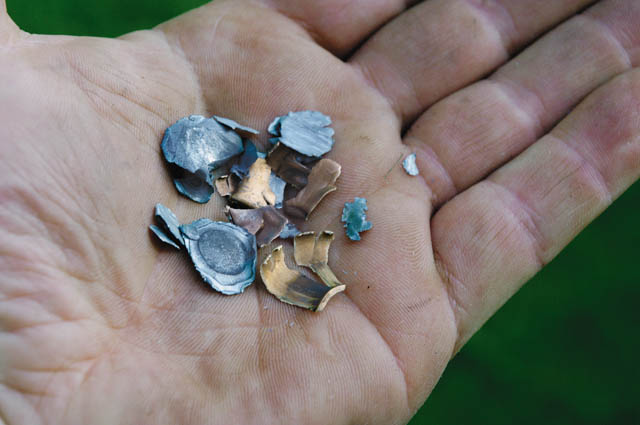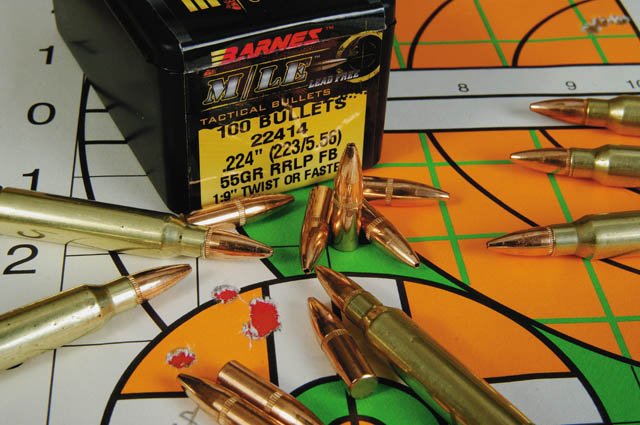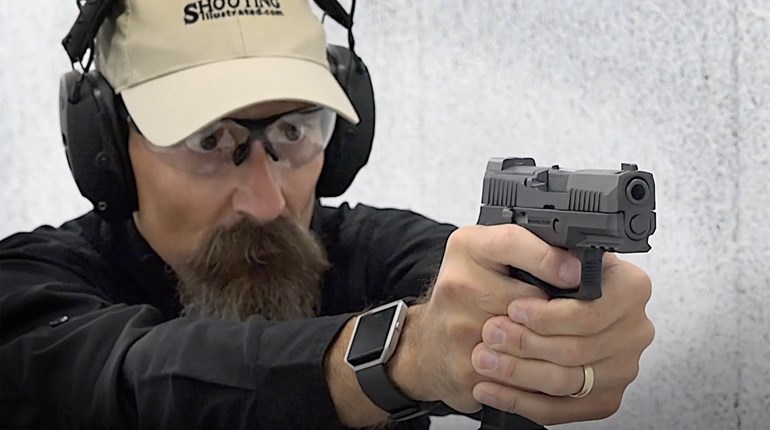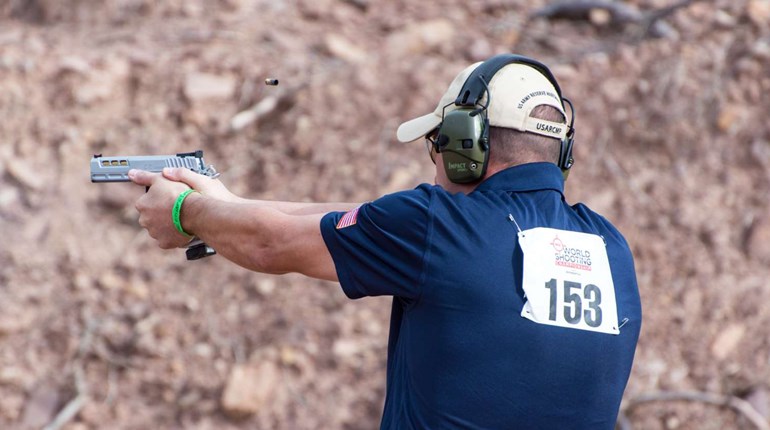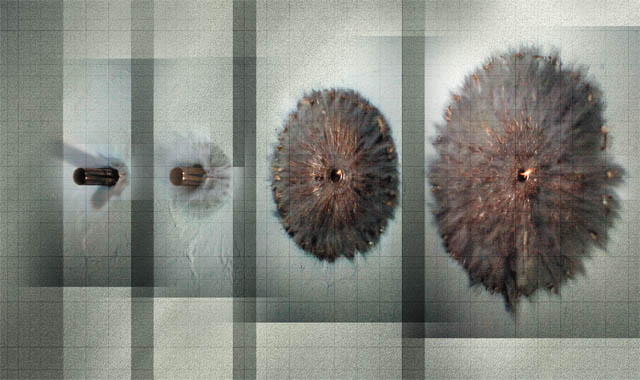
Steel targets have become popular for training and competition for a number of very good reasons. The instant feedback (and hopefully gratification) is one thing, but a reactive steel target can also provide a challenge not found with paper. Targets like the Texas Star and MGM Double Spinner are good examples. These multi-hit targets move with each bullet strike, so you need to change your point of aim to connect with the next shot. If you want to really test your skills, go head-to-head with a good shooter on a dueling tree. If the competitors are evenly matched, the duel can go on for a long time and may even require a speed reload or two. Static sheets of paper can't compare to any of that.
If you shoot a lot, steel targets also wind up being cost-effective. I just priced some new IDPA cardboard targets. In lots of 100, they run about 65 cents each, plus shipping. For about the price of 600 IDPA targets, you can own a six-plate dueling tree. Six hundred cardboard targets will not get a serious shooter through a season, but my Action Targets dueling tree is more than five years old and still going strong.
However, there is a danger in shooting steel, particularly at close range. Whether you're a cowboy action buff or a USPSA competitor, you are likely familiar with or have experienced splashback. Steel targets can deflect smallbullet fragments back at shooters and bystanders.
Leaving a Mark
Usually splashback is just an annoyance, but it can be hazardous. I was at a range once with a few other shooters, trying to photograph a new pistol tracer round an ammo company was selling as a training aid. We were shooting a steel target that was full of deep pockmarks from the soft steel being pounded by cartridges too powerful for it to handle. A large piece of bullet splashed back from 18 yards, hitting my cousin in the leg. It penetrated his new blue jeans and his large, muscular leg with enough force to crack his femur.
Granted, that was an extreme case, caused by a bad confluence of problems. The hollow-base construction of the bullet caused it to break into large pieces, and we should not have been shooting at a damaged target.However, splashback can happen even with proven bullet designs and steel that's in good condition.
A few weeks back, I was practicing for a match using 9 mm hardball ammo. One of the bullet jackets flattened on impact with the steel target and became a miniature buzz-saw blade flying through the air. The splashback caught the side of my ribs, slicing my chest with its high-speed, razor-sharp edge. The result was a bloody shirt, a small scar and a lesson: I was shooting too close to the steel.
Distance is the best remedy for splashback, since bullet particles do not, as a rule, fly very far. But, the key to a lot of action shooting is having targets up close and personal. It helps to angle the steel so the top is tipped forward to direct the bullet down, but that's not possible with every target style.
From Dust to Dust
One of the best approaches is to do what the International Cartridge Corporation (ICC) Lead-Free Championship was designed to showcase: Use frangible bullets for training on steel targets at CQB distances. The Lead-Free Championship is hosted by ICC at its Reynoldsville, PA, facility as a way of showing gratitude to active-duty and retired military, law enforcement, EMS and emergency-room personnel, as well as firefighters and other first responders. Competitors must fall into one of these categories. All firearms are provided by ICC—no advantages to those with tricked-out raceguns here—and the entire match is shot exclusively with frangible ammo.
The frangible bullets used by ICC in its Green Elite TR and Green Elite NT pistol training rounds—as well as those designed by other manufacturers for safe, up-close work on steel—are usually made by a variation of a process called sintering. This method heats a powdered material to just below its melting point until its particles adhere to each other. Frangible bullets are generally a composite of powdered copper and tin formed under extremely high pressure and heat. They have no jacket, and the powdered metal breaks into dust upon impact with any harder material, such as a target's steel. Other frangible bullets are made from a matrix of powdered copper and nylon. These are injection molded and also completely disintegrate upon impact.
Some frangible bullets—usually for rifle cartridges—use powdered-metal cores inside a jacket. Examples are the Barnes M/LE RRLP (Reduced Ricochet, Limited Penetration)—which ICC loads in .223 Rem., .308 Win. and 7.62x39 mm for its Green Elite JOT (Jacketed Open Tip) line—and the bullets used by Dynamic Research Technologies in its line of rifle ammo. Jacketed frangible bullets are capable of extreme accuracy. They also offer increased durability over totally frangible bullets, which makes them less likely to become damaged during loading or handling. However, the jacket material can cause splashback at close range, and they are best reserved for steel targets that are at least 50 yards away.
With totally frangible or copper/nylon bullets, you can shoot steel targets at close range without the worry of splashback. How close? Well, I have seen demonstrations where a guy wearing sneakers stood on a plate and emptied a pistol into the steel between his feet. Nobody recommends trying that—for a lot of reasons. However, most agree you are safe shooting steel as close as 15 feet with these bullets.
Saving Paper
I am a hands-on kind of guy, so I decided to conduct my own test. I placed a couple of different steel targets in front of the backstop in my backyard range and put paper targets 5 feet in front of them. First, I tested the ICC Green Elite NT and HP Duty pistol ammo, shooting 10 rounds each of 9 mm, .40 S&W and .45 ACP at the steel. After 30 rounds smashing against steel, there was no evidence of splashback; the paper targets remained unmarked.
Next, I loaded 10 rounds of Green Elite NT .223 Rem. ammo in an AR-15 and shot at the steel. Even with the higher velocity of bullets launched from a rifle, the paper was not touched.
When I switched to conventional jacketed bullets, there was some splashback that tore holes in the paper. Notably, there was far less splashback with an angled target than with one hung straight up and down on the frame, demonstrating that target placement and orientation can control splashback to a degree. But again, not all steel targets give you the option of placing them at an angle on the frame, and even then it changes presentation to the shooter.
Finally, I set fresh paper targets directly off to the sides of the steel so they would catch particles that deflected to the left and right of the target. After more shooting with the Green Elite NT pistol rounds, the paper was peppered with hundreds of small marks, but most did not penetrate it.
Dan Smith, ICC's vice president of operations, often demonstrates shooting at steel from a few inches away with his company's frangible training rounds. He told me it feels like a windy day at the beach, as the muzzle blast blows the particles back at him. I suspect the paper targets had the same experience during my test. It looked more like they had been sandblasted than shot. But when I tested FMJ ammo with the same target placement, the paper was shredded, and some of the holes were pretty big.
Plenty More Pluses
Besides minimizing splashback, frangible bullets eliminate another potential downside of some steel targets—ricochet—an issue in today's increasingly crowded countryside. Since frangible bullets disintegrate into thousands of tiny particles upon impact with steel, you need not worry about them flying into parts unknown.
As the ICC Lead-Free Championship suggests, frangible bullets do not contain lead. Some ranges mandate shooters use lead-free bullets, and frangible ammo meets that requirement. The Green Elite NT line from ICC, along with some frangible ammo from other manufacturers, is also loaded with lead-free primers. These loads can be used on any of the indoor ranges that require ammo to be completely lead-free.
Another positive aspect of frangible bullets is they are less damaging to steel targets, which helps extend their lifespan. After investing $1,000 in a new plate rack, you want it to last as long as possible, right? The key to shooting steel targets with rifle ammo—even when using frangible bullets—is to keep the impact velocity low. With commercial targets made of rifle-rated AR500 or AR550 steel, impact velocity should be well below 3,000 fps. Even when shooting frangible bullets, I found my AR500 steel targets would have a dimple I could feel with my finger if the bullet impacted at 2,900 fps. When I lowered the impact velocity to 2,700 fps, there was no damage. If you are going to train at close quarters with your rifle, consider using reduced-velocity loads like those available from ICC.
Accuracy with frangible loads, like any other ammunition, is subject to the whims and intracacies of the firearms being used. Frangible bullets can be bore sensitive, because sintered bullets cannot obturate in the bore and swell to fill an oversized condition. However, I tested handloaded sintered bullets in several AR-15s and got five, five-shot groups that averaged right at a 1 MOA, with the best group being .7 inch. I have done less-formaltesting with my handguns, but I have found that most frangible pistol ammo rivals conventional ammo in accuracy.
But what does it matter? Frangible ammo is designed for close-range work on steel targets. So what if your gun shoots 1.5 MOA instead of .5 MOA. Will that make you miss at 5 yards?
For the longer-range work, try jacketed frangible bullets like the Barnes M/LE RRLP or MPG (Multi-Purpose Green). They are extremely accurate and lead free. Plus, their frangible properties greatly reduce the risk of a ricochet and make them less damaging to steel targets.
One slight downside to frangible bullets is they tend to be light for their caliber. Point of impact with frangible loads may be a little different than with other ammo used for training or personal protection. I haven't found it to be a big issue for close-range training. At those kind of distances, point-of-impact shift is likely minimal. You could change the settings on adjustable sights or optics if it bothers you, but be sure to return to the zero you use for your self-defense loads—and check it—when you are finished with your practice session. While most frangible loads aren't ideal for self-defense, there are options for this task.
Steel targets can challenge your skills and add realism to your training. But using self-defense ammuntion or FMJs only increases the chances of splashback toward both you and bystanders. Why not avoid the problem entirely with today's generation of frangible ammo, which keeps shooting safe?
When the steel is close, go with frangible. Or you can always bring lots of Band-Aids.
